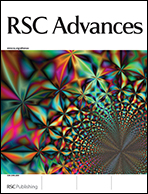Hydroxyl- and chloro-bridges as “structural assistants” in the construction of two new Keggin-based 3D frameworks†
Abstract
Two new Keggin-based three dimensional (3D) frameworks, [CuI4(btb)2(μ-OH)(PW12O40)] (1) and [CuII2(btb)4(μ-Cl)(PW12O40)]·3H2O (2) (btb = 1,4-bis(1,2,4-triazol-1-y1)butane), were synthesized and structurally characterized. In compound 1, the metal–organic subunit is a wave-like 2D layer consisting of ellipse-shaped tetra-nuclear CuI cycles. Furthermore, these layers are bridged by hydroxyl groups through Cu–(OH)–Cu bonds, resulting in the construction of a 3D porous metal–organic framework (MOF). The Keggin anions, acting as inorganic templates, are embedded in the channels of the structure. In compound 2, a 2D CuII–btb layer exists that incorporates quadrangular tetra-nuclear CuII cycles. The two adjacent layers covalently capture the Keggin anions between them to construct a hamburger-like subunit. Furthermore, these subunits are linked by chloro-bridges (Cu–Cl–Cu), which build a 3D framework with channels. The big voids in the channels led to a two-fold interpenetrating structure for compound 2. Additionally, the photocatalytic properties and electrochemical behavior of compounds 1 and 2 have been investigated.


 Please wait while we load your content...
Please wait while we load your content...